|
|
|
GOITRED GAZELLE (Gazella subgutturosa)

Study Site: Ecocenter "Djeiran" (Bukhara prov., Uzbekistan).
Dates: Since 2008 onwards.
Participants: Efremova Kseniya, Lapshina Ekaterina, Volodin Ilya, Volodina Elena.
Collaborators: Soldatova Natalia (Ecocenter "Djeiran"), Frey Roland (Leibniz Institute for Zoo and Wildlife Research (IZW), Berlin, Germany), Makarov Ilya (Institute for information transmission problems RAS).
Popular papers: <Science & Life>, <Priroda>. |
|
We conduct a combined study (acoustical, anatomical, behavioural, computer modeling) of adult and offspring goitred gazelles, wild and human raised.
There are four branches of research:
-
Ontogenesis of body mass, vocal anatomy and acoustic structure of vocalizations.
-
Ontogenesis and prominence of vocal cues to body size in adult, juvenile, and adolescent male and female goitred gazelles.
-
A combined study of acoustic, vocal anatomy and rutting behaviour of free-living male goitred gazelles.
-
Vocalization of free-living and captive female and offspring.
Up to recently, the descendent larynx was considered to be unique for humans, as a prerequisite to speech, for the account of releasing the additional space for articullatory movements of the tongue. In spite of the equal speech abilities in male and female humans, male larynx is twice larger and positioned much lower in the neck compared to the female one. At the same time, children have not differences in vocal anatomy between sexes. The gender differences arise at puberty, when larynges of boys have a second descend and starts voice breaking, whose physical correlate is abrupt lowering in voice pitch. Men pay strong costs for this seemingly unimportant for speech gain: adolescent boys die from suffocation 14 times more often compared to adolescent girls. No one primate besides humans has the descendent larynx.
However, the permanently descendent and retractable larynges are found in harem-holding deer and gazelles: red deer Cervus elaphus, fallow deer Dama dama and Mongolian gazelle Procapra gutturosa. These peculiarities in vocal anatomy allow the males to produce during the rut calls with low resonant and fundamental frequencies, deterring rival males and attracting females. Probable, the descendent larynx and sex dimorphism in ungulates and people evolved evolutionary under the same selection pressure of sexual selection.
Another bovid species with fair sexual dimorphism in vocal apparatus between sexes is the object of this study, the goitred gazelle Gazella subgutturosa. In adult male gpitred gazelles, the larynx is strongly enlarged (mainly, for the account of thyroid cartilage), mobile, and rests very low in the neck compared to females. During the rut (in October-November) males try to attract females and to keep them on their territories. With this purpose, they use vocal behaviour and produce roars, retracting simultaneously the larynx back, up to the sternum. At maximal retraction, fourteen tracheal rings penetrate the lungs! Most probable, such specific anatomy of vocal apparatus, vocal behaviour and the structure of vocalizations in male gazelles evolved under pressure of sexual selection. To understand how and in what age these peculiarities arise in goitred gazelles, we study formation of sex differences of vocal apparatus along ontogenesis. Up to now, no studies of such sort have been done for any ungulate species.
  Sounds in the Gallery. Sounds in the Gallery.
|
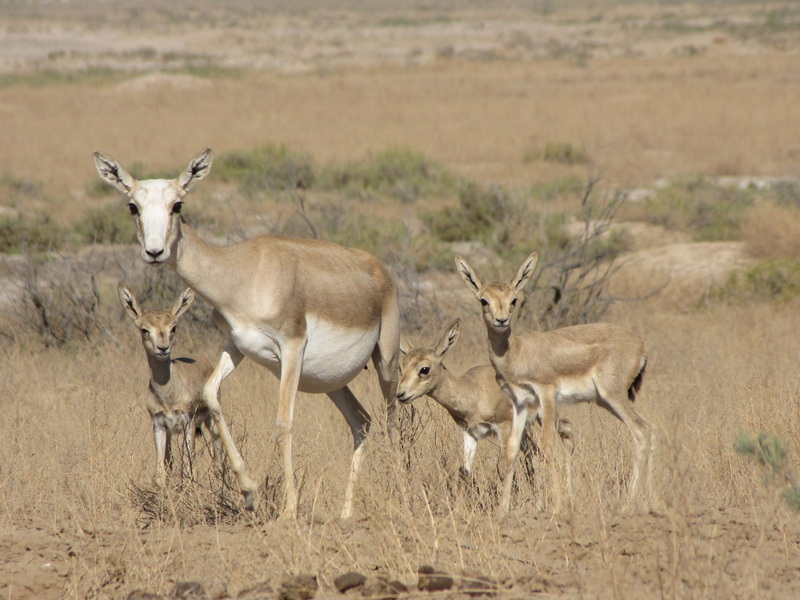 |
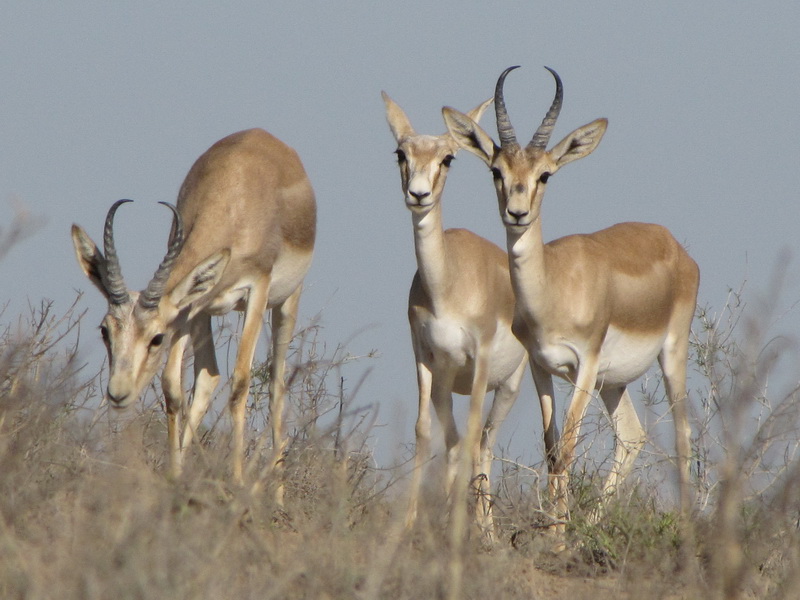 |
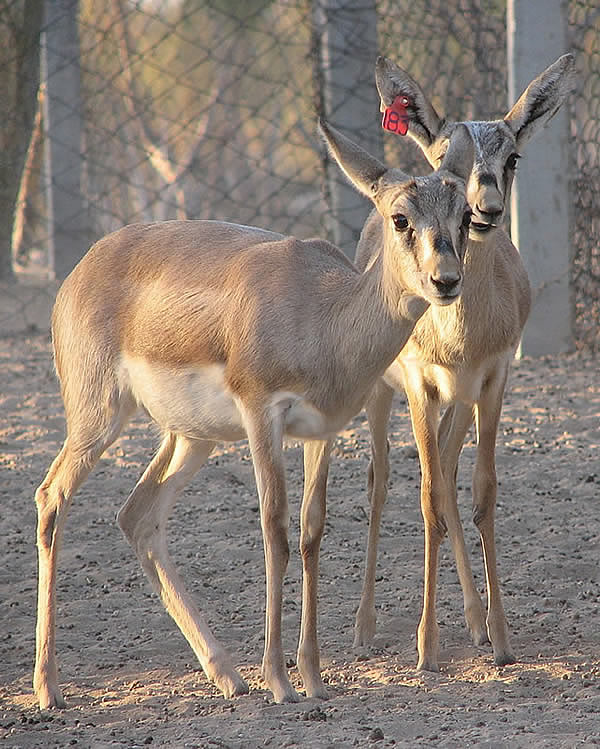
|
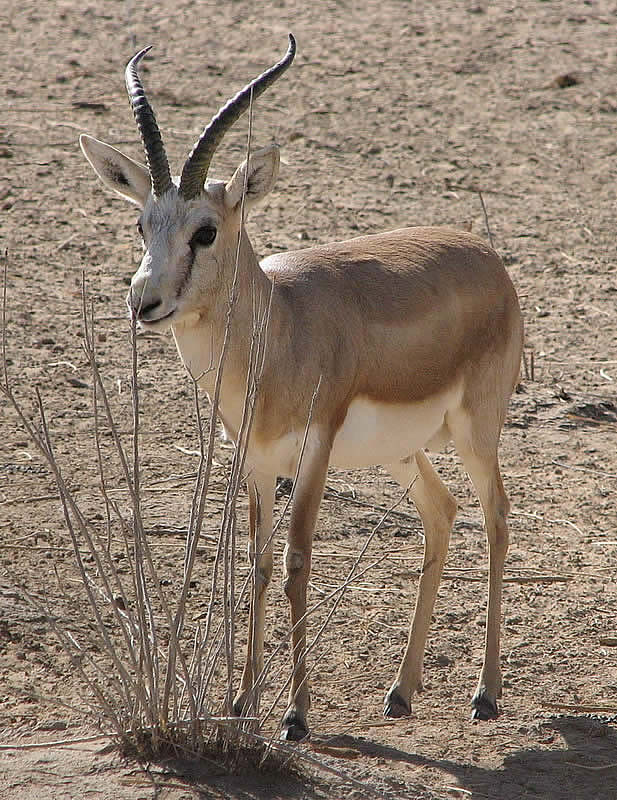 |
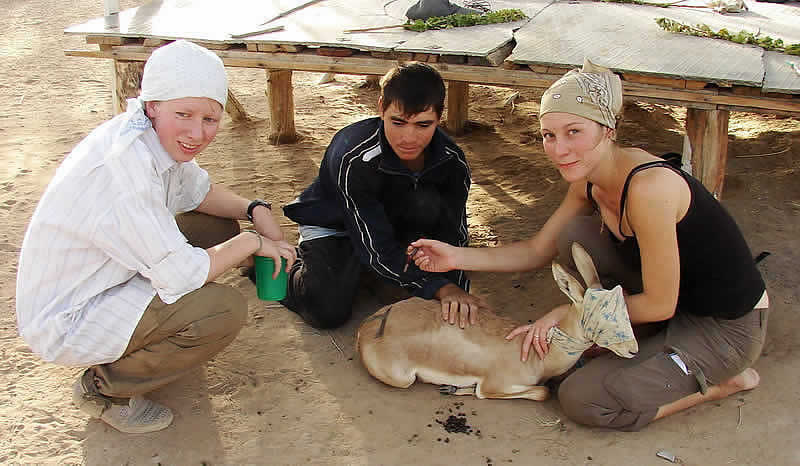
|
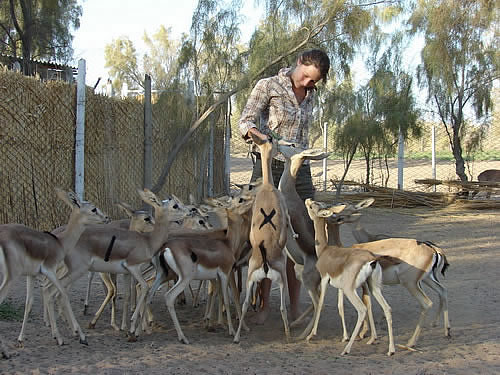
|
| |
|
Papers:
- Sibiryakova O.V., Volodin I.A., Soldatova N.V., Volodina E.V. Acoustic structure and individuality in contact calls of adult female and neonate goitred gazelles // Zoosociology of terrestrial vertebrates (ed. Mitropolskiy M.G.), Tashkent, 2018, p. 98-105. (available in Russian) 248.pdf
-
Volodin I.A., Volodina E.V., Frey R., Kirilyuk V.E., Naidenko S.V. Unusually high-pitched neonate distress calls of the open-habitat Mongolian gazelle (Procapra gutturosa) and their anatomical and hormonal predictors // Science of Nature, 2017, 104, 50. 236.pdf
-
Volodin I.A., Sibiryakova O.V., Frey R., Efremova K.O., Soldatova N.V., Zuther S., Kisebaev T.B., Salemgareev A.R., Volodina E.V. Individuality of distress and discomfort calls in neonates with bass voices: wild- living goitred gazelles (Gazella subgutturosa) and saiga antelopes (Saiga tatarica) // Ethology, 2017, v. 123, N 5, p. 386–396. 234.pdf
-
Volodin I.A., Efremova K.O., Frey R., Soldatova N.V., Volodina E.V. Vocal changes accompanying the descent of the larynx duringontogeny from neonates to adults in male and female goitred gazelles (Gazella subgutturosa) // Zoology, 2017, V. 120, N 1. p. 31-41. 231.pdf
-
Efremova K.O., Frey R., Volodin I.A., Fritsch G., Soldatova N.V., Volodina E.V. The postnatal ontogeny of the sexually dimorphic vocal apparatus in goitred gazelles (Gazella subgutturosa) // Journal of Morphology, 2016, V. 277, N 6, P. 826-844. 226.pdf
- Volodin I.A., Volodina E.V., Lapshina E.N., Efremova K.O., Soldatova N.V. Vocal group signatures in the goitred gazelle Gazella subgutturosa // Animal Cognition, 2014, v. 17, ¹ 2, p.349-357. 198.pdf
-
Volodin I.A., Makarov I.S., Efremova K.O., Volodina E.V., Soldatova N.V. Application of software for automatic analysis of human speech to measuring the fundamental frequency in calls of a nonhuman mammal // “Scientific researches in Zoological Parks”, Iss. 28, Moscow, 2012, p. 94-102. (available in Russian) 192.pdf
- Lapshina E.N., Volodin I.A., Volodina E.V., Frey R., Efremova K.O., Soldatova N.V. The ontogeny of acoustic individuality in the nasal calls of captive goitred gazelles, Gazella subgutturosa // Behavioural Processes, 2012, v. 90, N 3, p. 323-330. 189.pdf
- Efremova K.O., Volodin I.A., Volodina E.V., Frey R., Lapshina E.N., Soldatova N.V. Developmental changes of nasal and oral calls in the goitred gazelle Gazella subgutturosa, a nonhuman mammal with a sexually dimorphic and descended larynx // Naturwissenschaften, 2011, v. 98, N 11, p. 919-931. 185.pdf
- Efremova K.O., Lapshina E.N., Volodin I.A., Soldatova N.V. Structural diversity of of calls of goitred gazelle calves (Gazella subgutturosa) and changes in their occurrence along ontogenesis // Current problems of ecology and evolution in the studies of young scientists (V.V. Rojnov, ed.). Moscow: KMK Scientific Press. 2010. pp. 108-113. (available in Russian) 184.pdf
-
Efremova K.O. , VolodinI.A. , Volodina E.V., Frey R., Soldatova N.V., Lapshina E.N., Makarov I.S., Gorbunov K.S. Sex and age effects on the structural features of nasal calls and body size in the goitred gazelle, Gazella subgutturosa (Artiodactyla, Bovidae) calves // Zoologicheskii Zhurnal, v. 90, N 5, p. 603-615. (available in Russian)183.pdf
-
Frey R., Volodin I., Volodina E., Soldatova N.V., Juldaschev E.T. Descended and mobile larynx, vocal tract elongation and rutting roars in male goitred gazelles (Gazella subgutturosa Güldenstaedt, 1780) // Journal of Anatomy, 2011, v. 218, p. 566-585. 182.pdf
- Volodin I.A., Lapshina E.N., Volodina E.V., Frey R., Soldatova N.V. Nasal and oral calls in juvenile goitred gazelles (Gazella subgutturosa) and their potential to encode sex and identity // Ethology, 2011, v. 117, p. 294–308. 181.pdf
- Soldatova N., Juldashev E.,Volodin I., Volodina E., Efremova K., Lapshina E. Keeping, raising and body mass dynamics of the goitred gazelle calves (Gazella subgutturosa) in captivity //
“Scientific researches in Zoological Parks”, Iss. 26, Moscow, 2010, p. 64–71. (available in Russian) 176.pdf
|
|

